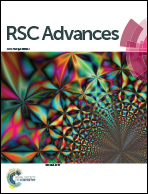Effect of oxidative treatment on the secondary structure of decoloured bloodmeal†
Abstract
Bloodmeal can be decoloured using peracetic acid resulting in a material with a pale-yellow colour which only needs sodium dodecyl sulphate, water and triethylene glycol to extrude into a semi-transparent bioplastic. Fourier-transform infrared (FTIR) spectroscopy using Synchrotron light was used to investigate the effect of peracetic acid treatment at various concentrations on the spatial distribution of secondary structures within particles of bloodmeal. Oxidation caused aggregation of helical structures into sheets and acetic acid suppressed sheet formation. Decolouring with peracetic acid led to particles with a higher degree of disorder at the outer edges and higher proportions of ordered structures at the core, consistent with the expected diffusion controlled heterogeneous phase decolouring reaction. The degradation of stabilizing intra- and intermolecular interactions and the presence of acetate ions results in increased chain mobility and greater amorphous content in the material, as evidenced by reduction in Tg and greater enthalpy of relaxation with increasing PAA concentration.


 Please wait while we load your content...
Please wait while we load your content...